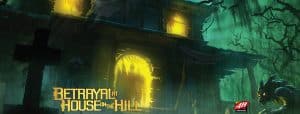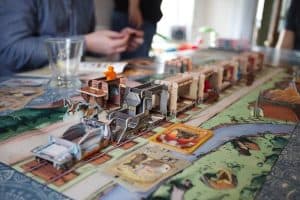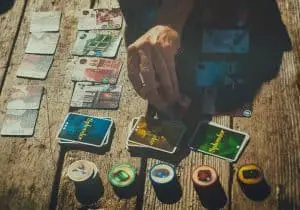Fantasy is one of the most popular themes in board games. Nothing quite scratches the roleplaying itch like exploring dungeons, fighting dragons or casting spells.
Fantasy games create universes of magic and wonder and are super immersive with rich story.
The fantasy theme has its roots from fantasy books like Tolkien’s Hobbit trilogy and Dungeons & Dragons – the immensely popular tabletop roleplaying game.
To me personally, fantasy games are some of my favorite board games to play. They allow me to escape into another world with my friends as we set out on whatever adventure the board game we decide to play sends us on.
Being a popular genre, it’s hard exactly to know which games shine and which fall flat.
I’ve put this article together to introduce what I believe are 10 of the best fantasy board games and why. So, wary warrior, grab your sword and shield and let’s begin!
Top 10 Best Fantasy Board Games
- Gloomhaven
- Descent: Journeys in the Dark 2nd Edition
- Mice and Mystics
- Blood Rage
- Runewars
- Small World
- Chaos in the Old World
- Legends of Andor
- War of the Ring
- BattleLore 2nd Edition
1. Gloomhaven
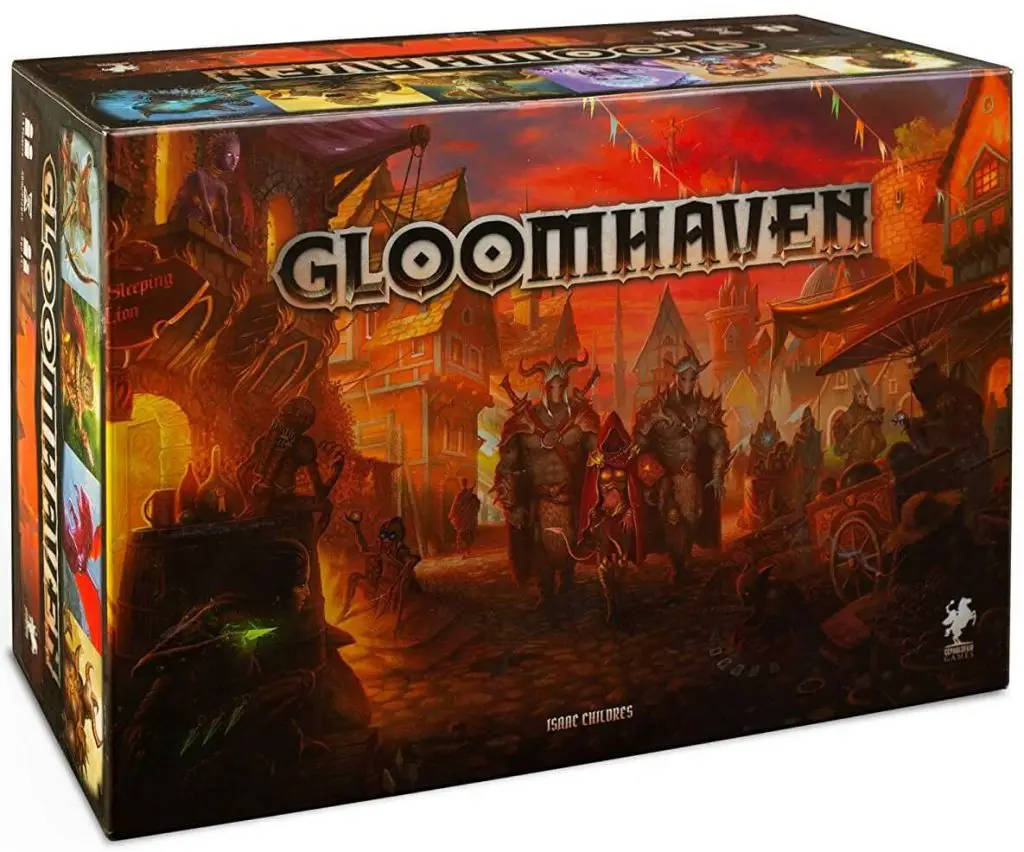
Gloomhaven is an epic roleplaying cooperative legacy style board game that puts players in the role of wandering adventurers with their own reasons for traveling to this dark corner of the world.
Modelled after a personal Dungeons & Dragons campaign. Game designer Isaac Childres has created a masterpiece of a game. At the time of writing it is the number 1 board game on boardgamegeek.
The game has an open world sandbox feel which really makes you feel like you are ‘choosing your own destiny’. This compounded with the fact that it also has legacy aspects, meaning decisions players make in the game are permanent, means the entire story and game world changes based on player choices.
Unlike other legacy games however, Gloomhaven does not require you to destroy game components or cards and instead opts to use the less aggressive ‘stickers’ route. Which is fantastic news, because it means the game is replayable (and trust me, you will want to play this game again once you crack it open).
Gameplay
Gloomhaven is a fully cooperation-based game meaning players need to work together and utilise each other’s strengths to overcome objectives in the game (and some of them are super tough).
Each player takes control over a hero character in the game, all of which boast a unique set of skills and talents.
The players travel through the world and make decisions about which objectives (scenarios) that they want to embark on, as well as ‘hero quests’, which when completed offer rewards that will help progress and strengthen characters throughout the game.
Objectives are like dungeon crawls, whereby generally it’s the party of players vs. a number of enemy AI creeps and a final boss.
The objectives vary in difficulty and some are downright tough, requiring players to level and gear up before even attempting them.
Combat in Gloomhaven is handled by cards rather than dice. Which is a huge advantage over other games, as instead of luck – players need to rely on strategy to emerge victoriously.
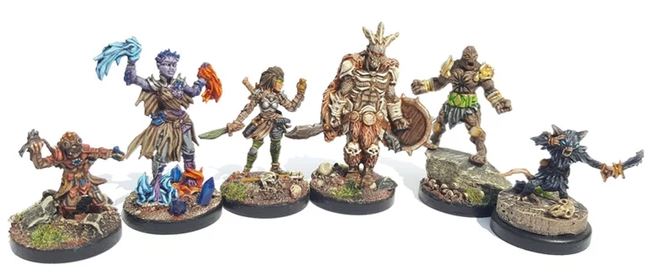
Cards utilise an initiative mechanic which determines the order actions in combat are carried out as well as by which members of the group.
Being able to sit down and strategize as a group the best way to take on an encounter is one of my favorite parts of Gloomhaven. It is hugely rewarding being able to outthink and dominate the AI of the game using planning and a bit of forethought.
In the game there are two main places characters can travel between being – the different scenarios players choose and Gloomhaven (a big city).
In Gloomhaven the city, players have the option to level their characters, buy and sell items, select new cards, donate to receive blessings (buffs) as well as complete city events.
The depth of Gloomhaven is huge, and I have only touched the surface with what I have written above. The game truly is amazing and is one of the most addictively immersive games I have ever played (coming a close second to Dungeons & Dragons)!
Bottom Line
Gloomhaven ticks every single box when it comes to an A+ fantasy board game. From character customisation, to the creatures and enemies, the game really creates a fantasy world where player interactions and choices really matter.
The game is super immersive, and it’s addictive to play. A few times my friends and I have found ourselves playing into the early hours of the morning without even realising it.
Pros:
- Unique card system
- Multiple hours of gameplay
- Game is incredibly immersive
- Classes are unique and have different abilities/play styles
- The game is balanced
- The rules are clean and easy to read and understand
- Loads of different enemy types keeps the game interesting
- Replayability
Cons:
- Enemy AI could use a bit of a tweak – movement is very simple
- The game can feel grindy
- Game takes a decent amount of time to set up
2. Descent: Journeys in the Dark 2nd Edition
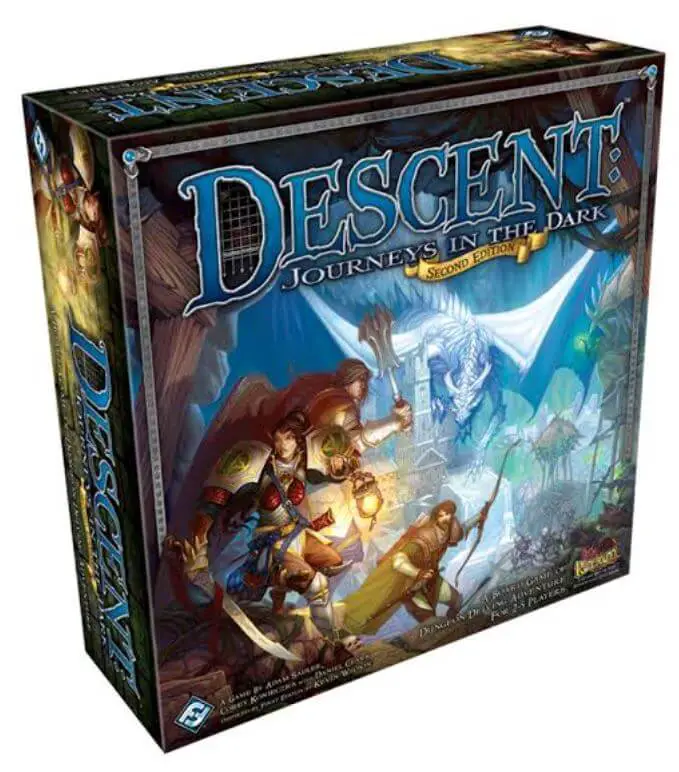
Players: 2 – 5
Duration: 120mins
Descent is another hugely popular and fun fantasy board game. Using a dungeon crawl style of play, it is unique in the fact that it utilizes a 1 vs all mechanic which can make for some super interesting scenarios.
In the game one player plays as the ‘overlord’ effectively taking control of all the creeps and monsters lurking in each dungeon (be it a cave, lost ruins or a cursed forest) that the players must enter.
All other players work cooperatively together to enter the dungeon and combat all that lies in their path to complete a specific objective.
The cool part of the game is that both the overlord and the other players are each given separate and conflicting win conditions – and of course, because the overlord is by himself, he’s given a little power boost.
Gameplay
As alluded to before, one player is the bad guy in this game and takes the role of the evil ‘overlord’. The other players all chose (up to 4) hero characters that will effectively play against the overlord – there are 8 different characters to choose from and 8 classes to assign (so tons of room for customisation).
Players can then choose to play missions (quests) which are either standalone games, or can be stringed together into a connectable campaign.
The mission will outline the background of the story and where the dungeon is located as well as how to set the board up using the games double sided hexagonal modular tiles.
Players and the overlord are then each given their specific win conditions – which are conflicting (meaning only one side can emerge victoriously).
The overlord player then gets to strategize and choose which monsters will be lurking in the dungeon – making for some pretty crazy battles.
One thing to note is that players in Descent cannot die. This means that the game is about strategy and is effectively a race against the clock. Players need to use their stamina and skills wisely as there is a detrimental fatigue mechanic.
The game also has a cool companion app that you can download for your smartphone. This allows solo play (although I have not tried it yet) as well as coop play if you instead would like the app to control the overlord. This is a great touch to an already awesome board game and means it gets spot number 2 on my list.
Bottom Line
Descent is by far one of the best modern dungeon crawl board games on the market. It has great mechanics, mission stories and components (including artwork) that make it a top tier fantasy themed board game.
The addition of Fantasy Flights companion app is the cherry on top and opens up a whole new way to play an already awesome game.
Pros:
- Character Variety and advancement – very well implemented
- Monster variety
- Overlord Mechanic
- Variation in missions
- Customization of the game
- Replayability
- Quality of components – A class
Cons:
- Game length – only 3 – 4 hours (pro or a con depending)
- Balance – Some situations are mathematically unwinnable
- Monster Health – most monsters are 1 hit kills
3. Mice and Mystics
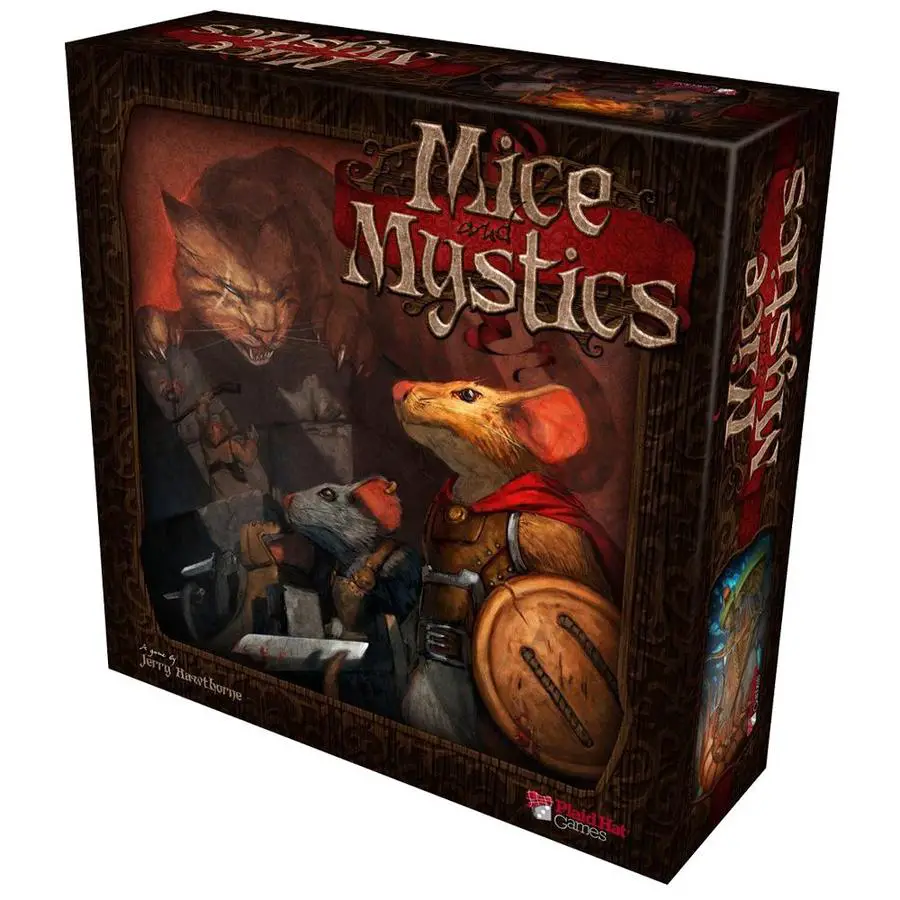
Mice and Mystics is a fantasy themed board game that is great to play for the whole family. It has an awesome story that players play through and is easy enough to teach the younger gamers how to play (yet is still fun to play for us adults).
The game is a silly and whimsical light hearted RPG, where players cooperatively play through missions, upgrade gear and special abilities.
I am a sucker for games with great lore and storytelling and the story of Mice and Mystics is really really cool – and most importantly for this article – is super full of fantasy themes!
Gameplay
As mentioned before, Mice and Mystics is a game all about the story. It is the overarching theme to the game and players essentially play through each chapter of a book that comes with the game.
The story revolves around a group of humans (the players) who live in a sort of a medieval fantasy world.
All players were confidants and trusted advisors to a king who has fallen ill because of the evil plans of this sorceress named Vanestra and her army of black-clad warriors.
Vanestra overthrows the king and all players are thrown into jail. Lucky there is a wizard in your party who can transform everyone into mice to escape the prison.
Unfortunately, however, turning back into humans is not so easy and you basically have to go through a series of adventures to try to save the kingdom and finally (hopefully) return to your prior human form.
Because the game revolves all around the story, I am not going to go into too much detail so as not to spoil anything other than to say it is really well thought out and really gets all players involved (children and adults).
Like Descent, Mice and Mystics also comes with a companion app (I love technology). The app does a great job of setting the scene and reading out the story components of the game as players work their way through.
Players need to work together to play through each different scenario (chapter) of the game. Each character in the game has a unique ability and stats that can be level up and improved as players progress.
Now, because it is a story, there will be some chapters where some characters are not available OR a character has not yet joined the story, allowing players to also try out different characters and play styles as the game moves forward.
Bottom Line
Overall, Mice and Mystics is a great family friendly fantasy board game.
Whether you are after a board game that is light hearted and fun to play or are just after a really great story – then Mice and Mystics is a great option.
There are also expansions available to the game which offer continuations of the story and new characters!
Pros:
- Fun light hearted game
- Can be played with children
- The game is fast paced
- Great game for beginner dungeon crawl / roleplay board gamers
Cons:
- The quality of the cards is lacking – needs a bit of care
- The game is made for families – no adult themes
4. Blood Rage
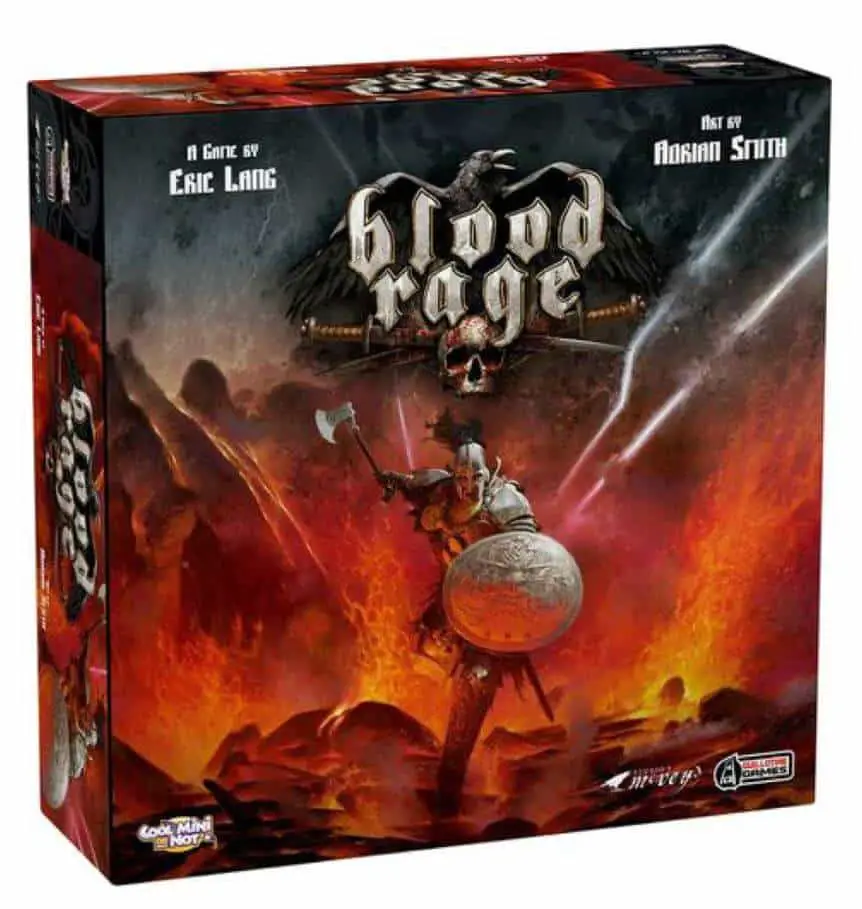
Players: 2 – 4
Duration: 60mins – 90mins
If you are a fan of detailed miniatures (I know I am!) then hold on to your helms because Blood Rage is a game that’s box is packed full of some of the coolest looking miniatures – AND THEY’RE VIKINGS!
In Blood Rage, players take on the roles of competing Viking clans who are all battling for the control over provinces – which, coincidentally are also systematically destroyed as the game progresses.
In the box you will find a really nice set of miniatures. Each player gets their own warriors (2 different types), a ship and a leader. In addition to these mini’s are also monsters and a hero each player can choose to play as.
The heroes are hilarious – the men are all different shapes, sizes and builds… whereas the women all look like they have come straight from a bikini shoot with an uncomfortable (but equally as funny) amount of under boob (forgive my maturity).
The game is played over 3 ages, with each player trying to pillage as many villages as possible with their army to earn glory points.
The player with the most glory points at the end being the victor.
Gameplay
At its core, Blood Rage is a combination of miniatures on a map, action selection and card drafting. All familiar mechanics and all implemented in a polished form in game. However, where the game truly shines is its theme (there’s just something so cool about battling Viking clans and fantasy monsters).
The idea of the game is simply that the world is coming to an end… so you may as well prove that you are the best clan of Vikings before it all comes to a close.
Play is split over 3 ages, each with 5 phases – with the winner being the clan that amasses the most glory points at the end.
At the start of the game the board which consists of up to 11 regions is set up, and before any play even begins… Ragnarök comes and destroys a significant portion of the map – the number of regions destroyed depends on the number of players.
This creates a very tightly packed board, with nowhere to run – making combat inevitable!
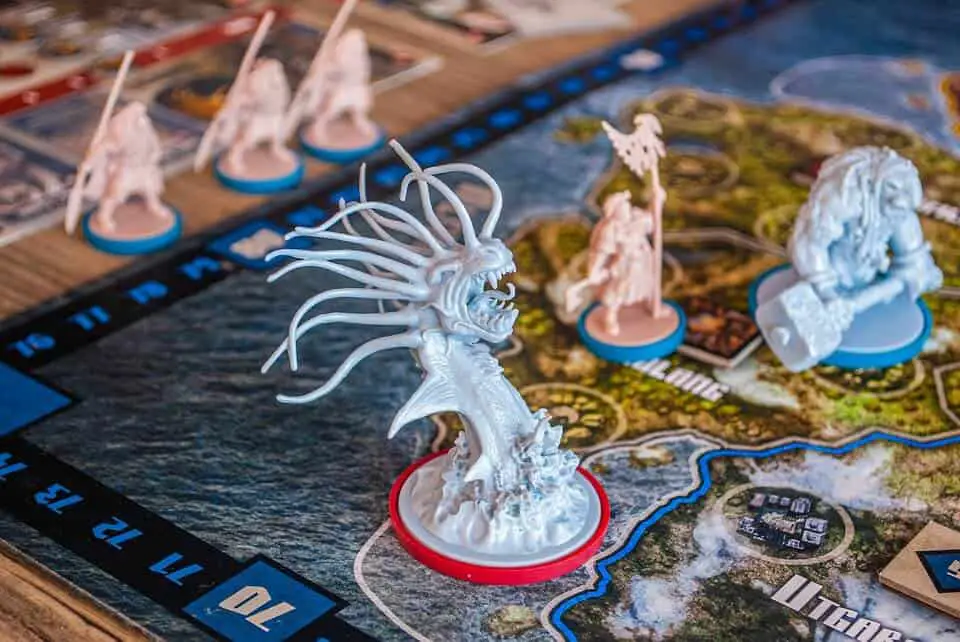
Drafting Phase
Play then begins with a drafting phase. A hand of eight cards is given to a player, who then chooses one of the cards and passes it on to the rest of the players (who also take a card). This continues until everyone has six cards.
Cards that can be drawn vary from quests that bring glory points, upgrades to your clan or battle cards which replace dice during combat.
Each card has a particular theme and is named after a certain Norse god. Each god is unique and offers a certain style of play which becomes evident through their cards – For example: Thor awards points for fighting, whereas Loki likes watching his subjects (your troopd) die.
This opens up a really fun way of developing strategies and focusing on a certain way to play the game – I particularly like sending my troops to Valhalla because I am evil like that!
Action Phase
During the action phase, players take cards from their hand and start putting them to use.
Placing miniatures on the board is called ‘invading’ where Vikings get to battle over who gets to pillage a certain region on the board.
Each region may only be pillaged once per turn, awarding the victor with stats and glory points.
If players both have warriors in the same zone – they are forced to fight. This is where the strategy comes to play.
Battles are determined based on warrior strength as well as the battle cards played (face down) by each player. For instance, if I play a Loki battle card, I am incentivised to let my warriors lose so that I can reap certain bonuses from the victor.
All warriors that are destroyed are sent to Valhalla (a section on the board).
Ragnarök Phase
Once all players have exhausted all actions the round ends. This starts the Ragnarök phase.
One region is completely wiped off the board and any units in that region die – earning victory points to the clan they came from – this is by far my favorite mechanic in the game. Points for having your miniatures destroyed by the gods!
At the end of each round, all players get their units back from Valhalla and play begins again.
This is done over 3 rounds, with the player to earn the most points at the end emerging the victor.
Bottom Line
Blood Rage is a super fun and high-quality fantasy board game, with some very unique mechanics which complement the theme in the perfect way.
If you like Vikings, mystical creatures (and a bit of silliness), then Blood Rage is a great game that has a ton of replay value and is perfect for a game night with a bit of Ale!
Pros:
- Great use of mechanics
- Accurate play time
- Awesome miniatures with overall high-quality components
- Under boob
Cons:
- Set up takes a bit of time
- Some players may not like the randomness of card drafting
- Under boob?
- Potential for a run-away leader
5. Runewars
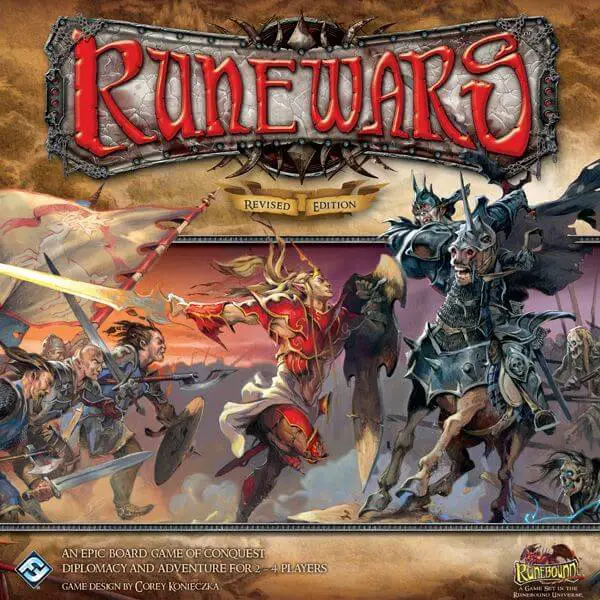
Players: 2 – 4
Duration: 180mins – 240mins
Runewars is an epic fantasy area control game designed for 2 to 4 players by Corey Konieczka and published by Fantasy Flight Games.
In the game players set out to conquer and negotiate their way to controlling regions of the board. The game is set in the same fantasy world as Descent which we looked at above – Rune Age!
The modular, dynamically constructed map sets the scene for the game and contains highly sought-after dragon runes (The key to winning the game).
The players objective is to locate and protect as many of these ruins as possible and prevent other players from doing the same, and they need to do it within 7 years (rounds).
Each year in game, consists of the four seasons (Summer, Autumn, Winter and Spring) with each season containing a number of ongoing effects that challenge players in their race to victory.
The game has four distinct fantasy factions for players to choose from with each faction having a unique set of units that you will use to battle, as well as unique abilities providing different play styles and strategies.
The game is hugely in depth and because of that the play time is massive. However, if you love really epic fantasy campaigns or don’t mind breaking play time up into multiple sessions then Runewars will reward you with a truly amazing fantasy strategy game with some of the best battles you could hope for with a board game.
Gameplay
At the start of the game each player chooses which faction they will play – Elves, Humans, Undead or Uthuk.
Like I mentioned earlier, the main goal of the game is to collect dragon runes. The issue is – there aren’t many of them and they are hard to find.
So, if an opponent gets one first, it could be a good idea to steal it from them!
However, to do that you will need to have a good army that can defeat theirs if a fight breaks out…
The game is played over a 7-year period which are the rounds of the game (yes its very long!). With each year broken further into seasons.
The game ends after one of the following win conditions are met:
- A player gains control of all six areas containing dragon runes;
- After the 7 years – the player with the most dragon runes wins.
During each season a card is drawn from the corresponding season deck. This card will contain special events that outline the circumstances of the season and the effects on players.
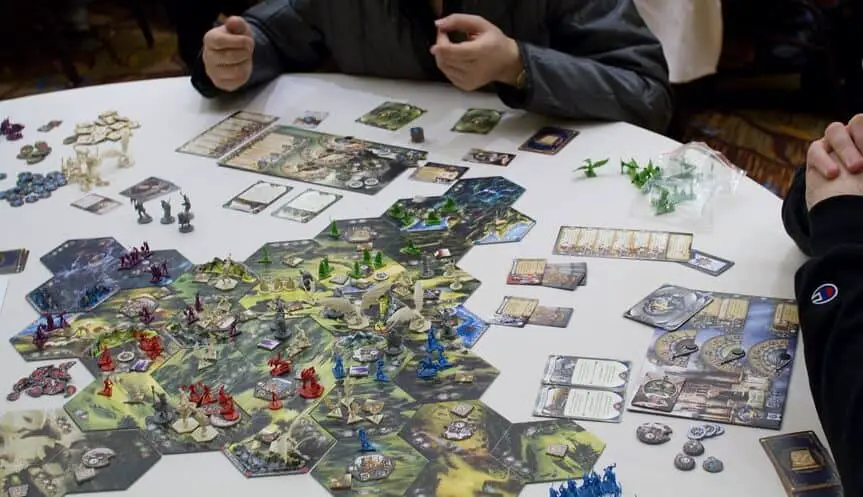
A season can be broken down into 3 phases as follows:
- Resolve a Season Card – Each season has a primary and secondary ability that is resolved. This can be things like in winter the water freezes and units can walk on water.
- Choose Order Cards – Players all have the same hand of eight cards. Every season each player chooses 1 card to play that determines their current action. Actions include recruiting troops, building strongholds, moving units, attacking and many other things.
Each order card can only be used once per year, so strategizing is of the utmost importance. After the year ends all cards are returned to the players hand and can be played again.
- Resolve Order Cards – Each players order cards are resolved in the order based on the number present on the card (some cards have the number 0, meaning they are resolved before any other player takes any action).
A full list of the rules can be found in this PDF.
A cool aspect of the game is that if you have a copy of Descent – they use the same hero miniatures. So you can have more hero minis to add to your Descent game!
Bottom Line
Runewars is a game that can only be described using the word epic.
It is a masterpiece of a game that is fun to play and boasts incredible plastic miniatures, beautiful artwork and high-quality cards and tokens.
The gameplay relies purely on strategy rather than luck, and the use of action cards forces players to think ahead.
There is also a healthy dose of player interaction and the ability to forge alliances and betray one another – which I personally think is great fun!
Pros:
- Great quality artwork, miniatures and components
- Relies on strategy not luck
- High player interaction
Cons:
- Extremely long game length
- Not beginner gamer friendly
6. Small World
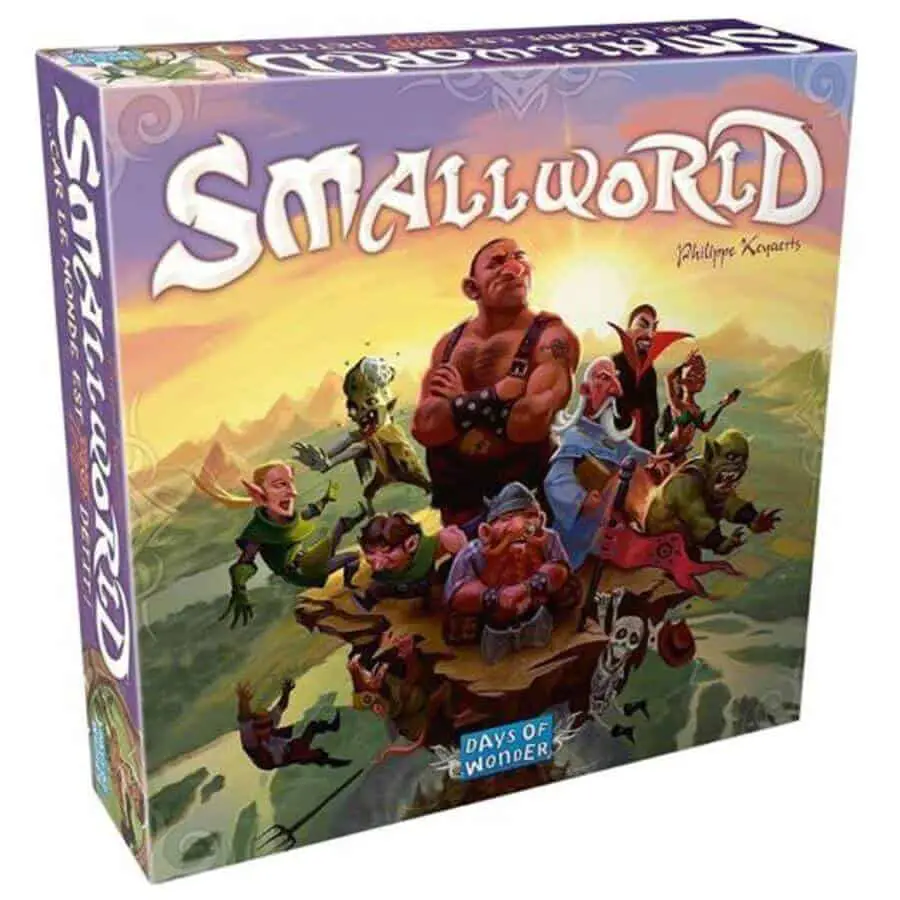
Players: 2 – 5
Duration: 40mins – 80mins
Small World, as the name suggests, is a fantasy game, whereby players all fight to control a world that is too small to accommodate them all.
At its heart, Small World is an area control war game with an awesome fantasy theme painted over top.
Players take control of orcs, elves and trolls as they attempt to have the largest area controlled on the map by the end of the game.
The game is very light hearted and social, where most of the moves are made outside of the game itself.
Small World is super nice to look at and is super easy to play – and is suitable for the younger gamers as well as the old!
Gameplay
At the start of the game the map (board) is placed on the table and assembled depending on the number of players.
Gameplay is very simple. Players win the game by having the most victory coins at the end. Victory coins are typically earned by controlling regions.
Each turn, players can carry out three actions:
1) Pick a race (if you don’t already have one);
2) Conquer regions on the board; and
3) Redeploy units for defence.
On a players first turn, they will select one race (in the form of a card) from a list of fantasy creatures and a trait to go along with that race.
Every race and trait has special powers that could help you conquer areas of the map faster, defend better, or gain more victory coins.
Picking the race at the top of the pile is free, while picking the race below it costs 1 victory coin, the race below that 2, and so on.
Each race card has two big numbers on them which indicates the amount of ‘tokens’ a player has to work with.
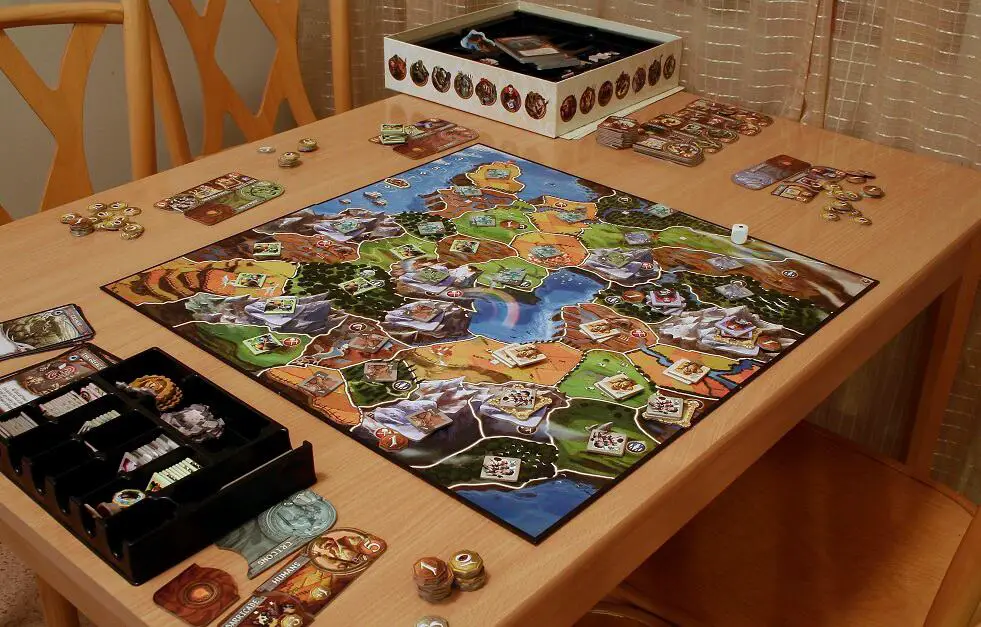
Starting on any edge or coastal region of the map, players begin to take over a region by placing 2 tokens there (plus 1 for every extra piece of cardboard on that region).
Some races or traits will make conquering easier: for instance, the mounted trait lets you take hills or farmlands for one less token than usual.
If you run out of tokens, but want to capture a region, you can roll the reinforcement dice once. If it lands on a number that is higher than the tokens you require you can conquer that region.
Once the turn ends player rearrange their tokens on the board for defence (making sure at least 1 token remains on each region they control).
Victory points are then awarded to players based on the number of regions they control.
Now the next player may select his race and conquest. Like the first player they can start taking over regions with their tokens, and if another players region is adjacent to one of theirs, they can take it over by simply placing more tokens than those defending the region.
If one player conquers another player’s region, one of the defending tokens is killed, returning to the game box, while the rest flee back into the defender’s hand to be redeployed at the end of the attacker’s turn.
Players are also able to swap out races and are able to control 2 (one active and one passive) at any one time.
At the end of the last turn, the player with the most victory coins wins the game!
As you can see the game is not at all complicated, but can become super competitive to play. It’s a great gateway game to teach new board game players!
Bottom Line
Small World is a short and light hearted fantasy war game with simple rules, streamlined gameplay and an awesome fantasy world setting.
The game is a great gateway board game for new gamers or to play as a family as it is really fun and super easy to learn (and there is no player elimination to trigger the little ones)!
Pros:
- Large range of races and traits – keeps the game fresh
- Fast paced easy to learn play
- Great visuals and artwork
Cons:
- Not very deep
- Players can gang up on a player who is getting ahead
7. Chaos in the Old World
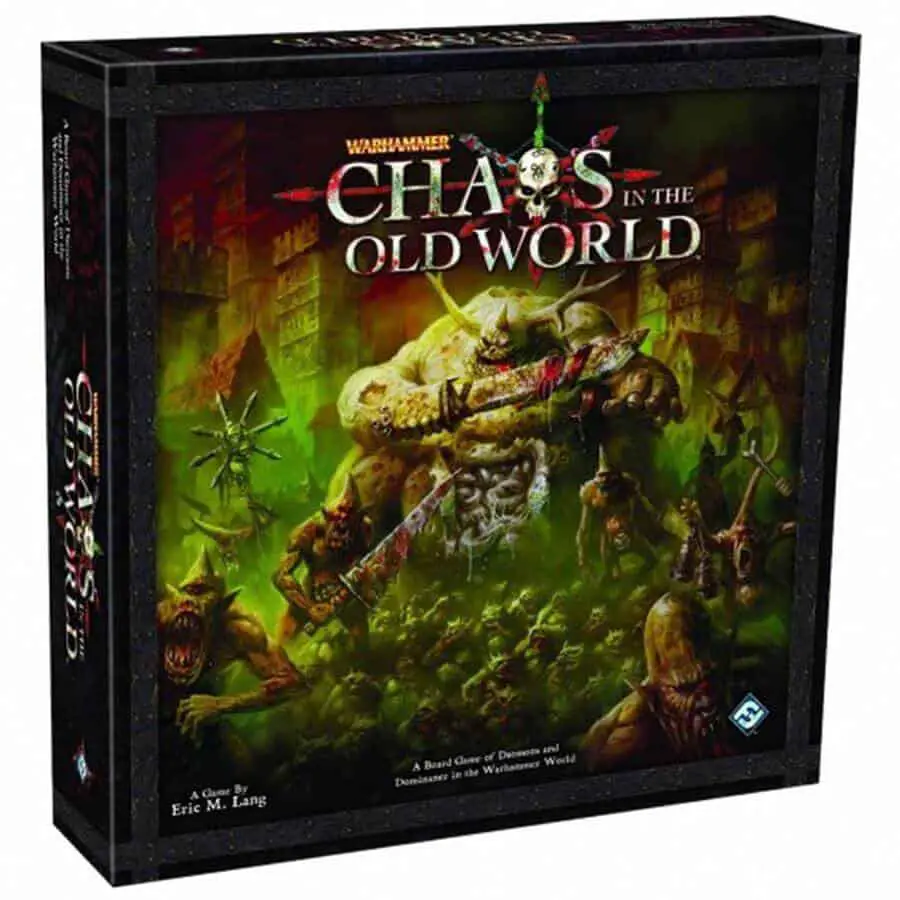
Players: 3 – 4
Duration: 60mins – 120mins
Chaos in the Old World is a board game in which the players play as gods and must compete against each other to corrupt the world to your liking. In other words, the game is all about who can be the most powerful bad guy!
The game is an area control resource game with plenty of battles to keep things interesting.
Players assume the role of 1 of 4 unique gods, each with different abilities and outlook on the world.
The idea is to use action cards to summon armies, battle enemies (the other players armies) and corrupt the land.
Chaos in the Old World has a great fantasy theme – albeit a bit on the darker side as you are playing as malevolent gods. It’s a lot of fun and the strategy is all about getting in the other players way and ruining their plans!
Gameplay
In Chaos in the Old World, players take on the role of 1 of 4 unique Chaos gods, each with their own unique playstyle, backstory and special abilities:
- Tzeentch – Is the god of magic. He casts spells!
- Nurgle – Is the god of disease. He spreads plagues and illness over the land!
- Slaanesh – Is the god of sin. He corrupts humans and gets them to carry out his every will!
- Khorne – Is the god of battle. Fights, fights and more fights.
Each god has their own special deck of cards that contain actions like upgrades, followers, spells and the different abilities the god can use.
The game is played over a series of rounds, with each round having a number phases to play through.
Chaos Phase – Each turn starts out with an event that happens on the board. This is decided by drawing a ‘chaos’ card from a deck of event cards.
Events are things that make the gods tasks harder – they can range from things like heroes joining the board to make battles more difficult to win or certain areas of the board not wanting to fight (which sucks for Khorne).
Action Phase – During the action phase players can use power points to play action cards. You can complete as many actions as you wish until your power points are completely depleted.
Actions are how the strategy of the game is played out. Do you want to cast a spell on a specific region or send a cultist to spread infection and corruption instead?
Battle Phase – This is where armies fight and the battle mechanic is very like Risk. Players roll a dice and based on the roll either ‘hit’ or ‘miss’ the enemy. Battles are contained to regions on the board.
Corruption Phase – The corruption phase, cultists for each god are counted based on the regions they are in and corruption tokens are added to those regions.
Once a region has enough corruption tokens, it is considered ruined and earns the god who ruined it a LOT of victory points.
Win Conditions
There are 2 ways for a player to win Chaos in the Old World and one which has the game beating the players:
- A player can upgrade their god to the final power stage;
- The first player to score 50 victory points; and
- Draw the last of the 7 Chaos (event) cards – the game wins!
Bottom Line
Chaos of the Old world is a brilliant dark fantasy themed area control board game that has players take on the role of gods.
Each game uses 7 of 20 Chaos event cards, and each god has different play styles and abilities. This means every time you play the game it is different and provides a ton of replay value.
Pros:
- Great dark fantasy theme
- Unique mechanics
- Multiple win conditions
- Huge replay value
Cons:
- Gameplay and strategy is deep – not new gamer friendly
- Some people may not like playing certain gods
8. Legends of Andor
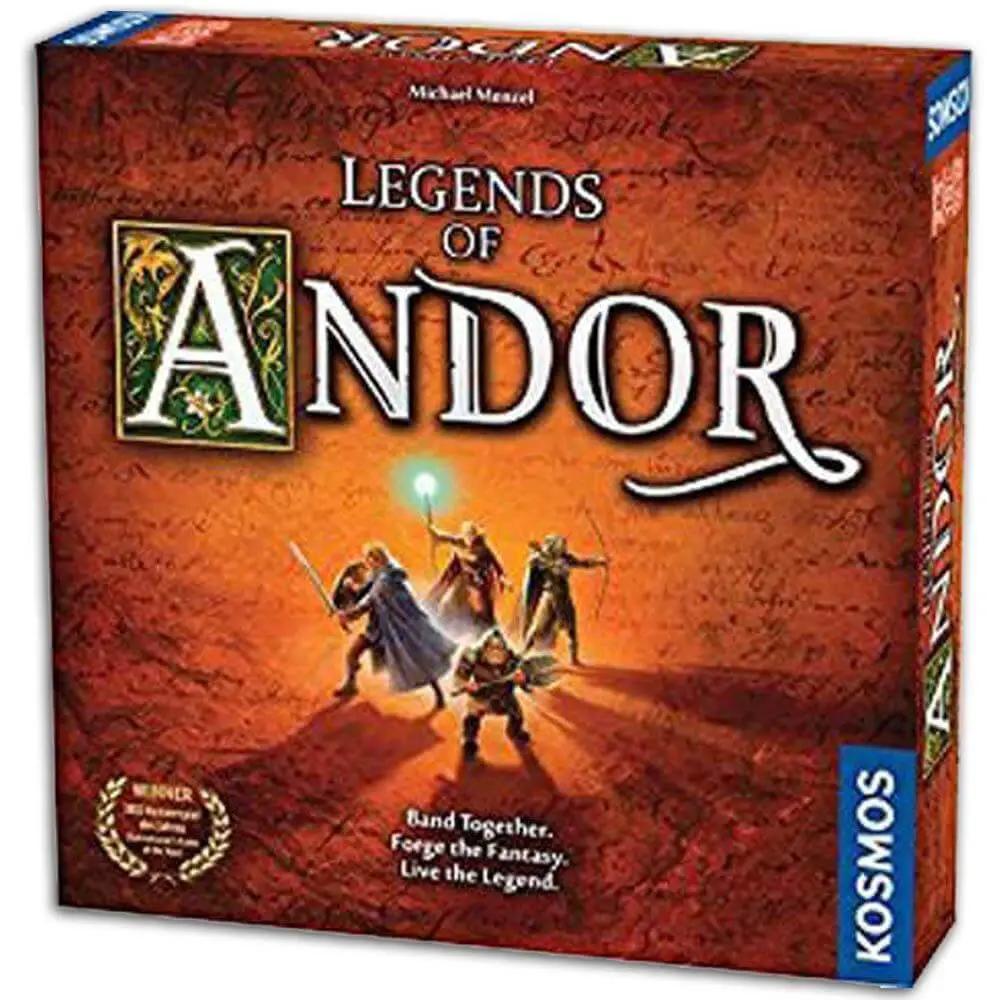
Legends of Andor is a cooperative fantasy board game where players each take on the role of a hero and have to work together to save the land Andor from waves of evil creatures that spawn and start to invade.
The game has 5 scenarios and probably the shortest rule book I have seen (only 5 pages). The majority of the game is learned while playing by the use of the Legends deck.
I really enjoy playing Legends of Andor. It has everything you could want from a cooperative adventure game –
- It has an interesting story;
- Provides really fun and different scenarios to play through that are narrative based;
- Plays well across multiple player counts; and
- Drives a ton of player interaction.
As well as the above it also requires deep thought due to its puzzle-driven system of monster paths, resource and time management.
Gameplay
At the start of the game players choose which hero they are going to play (dwarf, warrior, wizard or archer). Each with different play styles and abilities.
The game is played in rounds, with each round being a day in game time.
At the start of a round players are able to take actions with each action taking a certain amount of time (hence having to plan your day accordingly).
Actions a player can take are:
- Move: Each space moved is equal to an hour in game time;
- Fight: If a player lands in a space with creatures they can engage in battle with them;
- Pass: Players are able to pass and perform no action (generally for strategic purposes);
Actions continue around the table in a clockwise fashion until all players have performed their actions.
Each round and players turn are perfect opportunities to strategize and decide how the scenario should be handled as a team.
There are decisions to be made like who should ‘end the day’ effectively making that person the first person to act the next day, who should engage certain creatures and do they need back up etc.
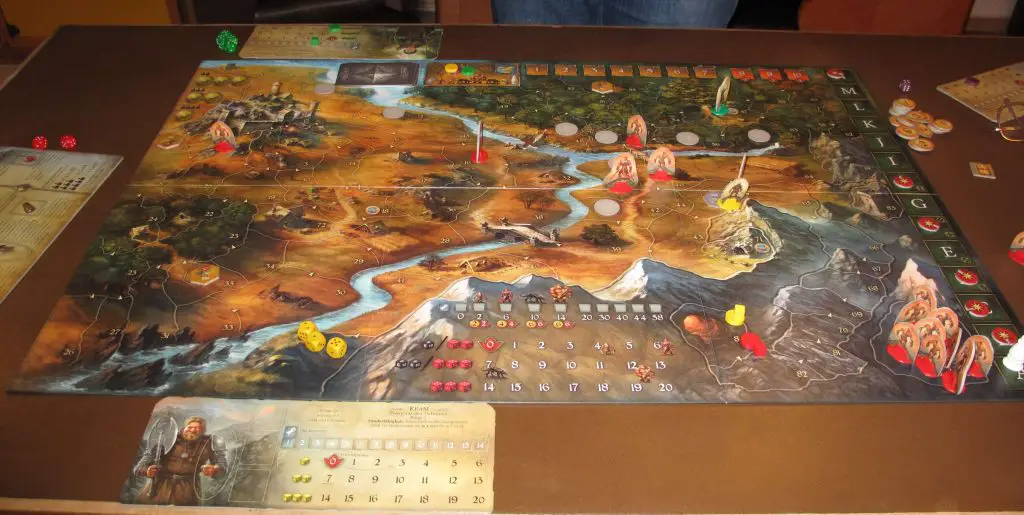
At the end of a day the following takes place:
- An event will be resolved;
- Creatures are moved around the board following the direction of the arrow on the space they occupy;
- Wells are refreshed (if no heroes occupy their space);
- The narrator track is moved forward and if appropriate the next card is drawn from the legends deck and resolved.
The day/night cycle continues like this until the scenario reaches the ‘end game’. This is different for each scenario, and due to the game being narrator and story based – I won’t ruin it for you in this article, other than to say the end game is the most intense and fun part of the game. It is super challenging and forces a ton of player interaction.
Bottom Line
Legends of Andor is a great fantasy themed cooperative adventure game.
The cooperation between the players really drives the game while they work together through the narrative based story objectives.
I really like the way the ‘legends’ deck drives how the story unfolds and often throws a spanner in the works.
You really have no idea how the story is going to play out and have to work together to handle everything the game throws at you.
Pros:
- Game focuses on cooperation for players to win
- Story is excellent and fun to play through
- Really great artwork and components
- Awesome fantasy theme
Cons:
- Game is scenario based, so limited replay value
- Space numbering can be annoying
9. War of the Ring
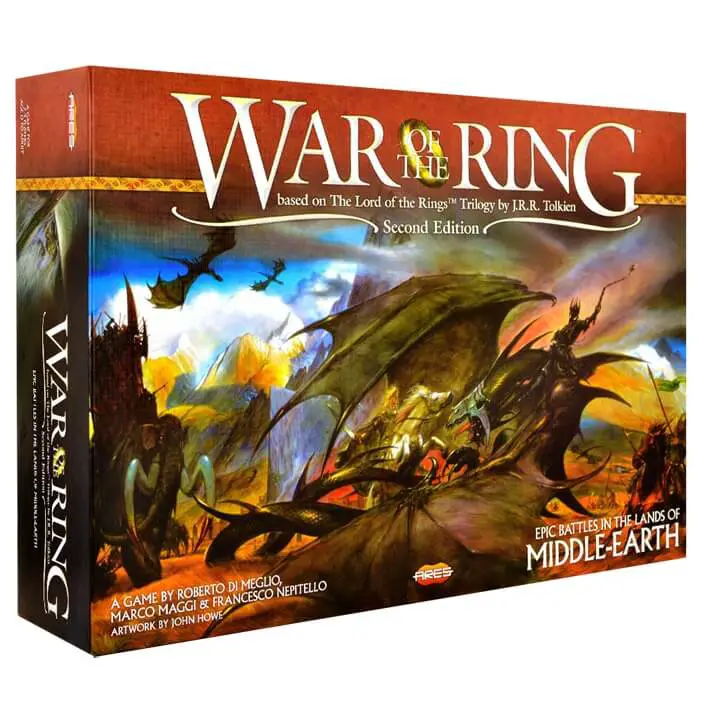
Players: 2 – 4
Duration: 150mins – 180mins+
If you are a fan of J.R.R Tolkiens – The Lord of the Rings or Hobbit, strategy-based war games and high fantasy…
Then War of the Ring is the one game to rule them all, and in the darkness bind them.
The game is set in the world of middle earth where players take control of the free people and the forces of shadow to fight in a war until one side emerges victoriously and controls the land.
The game is a magnificent area control strategy war game that absolutely oozes the Lord of the Ring theme through its character and event cards.
The game balances a typical war game style of play with a role-playing aspect that is just perfect for players who want to strategize but still be captivated by its story driven objectives.
Gameplay
The game itself is gigantic. The box is huge and contains a huge board and a load of themed miniatures. In order to play you will need a really big table or (like me) play on the floor.
The game is also quite detailed and deep meaning it really is for the hobbyist gamer. Because of this I will only briefly touch on how the game is played below.
At the start of the game, players are split into teams. Each team then chooses the army they will fight with – either the free people (Rohan, Gondor, Dwarves, Elves and the men of the North OR Sauron and his army of orcs and Uruks.
Like the books, the free people have one objective – to cast ‘the one ring’ into mount doom to destroy it. With the shadow player doing everything in their power to corrupt the fellowship on their journey to the mountain.
The game essentially plays out the books which in itself is epic – except the bad guys can actually win!
The main mechanic in the game revolves around the action dice. These are specially printed 6-sided dice that are rolled at the start of each round.
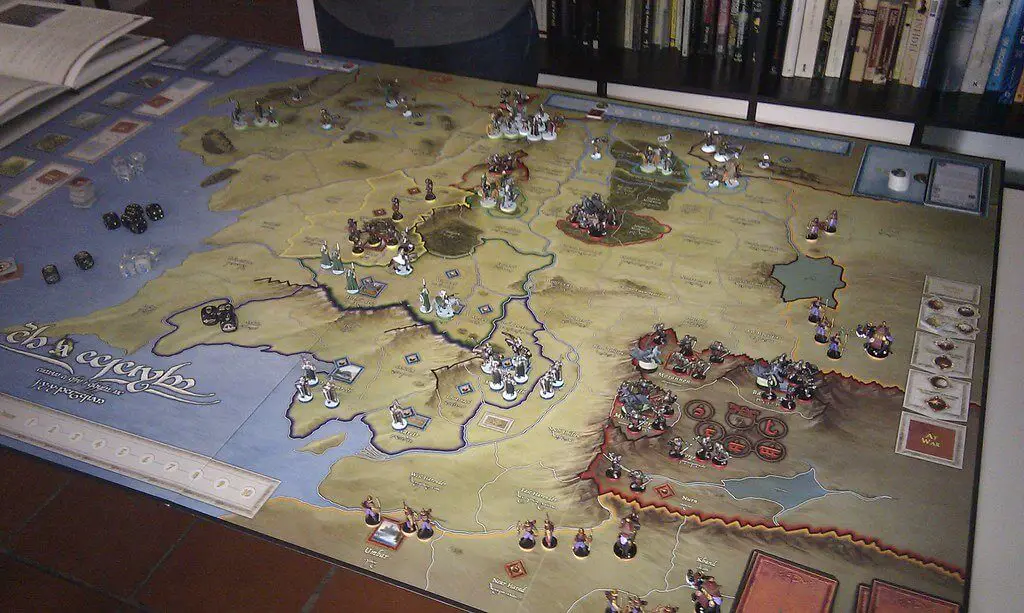
The different sides of the dice correspond to different actions:
- Moving troops;
- Recruiting more troops;
- Moving the fellowship; and
- Event cards.
During the game players roll action dice and perform actions until all the dice are used.
There are special characters that can enter the game also which allow special abilities and extra action dice – such as Saruman, Gandalf and even Tom Bombadil!
Combat in the game is dice based and uses regular 6 -sided die. Armies are trying to roll 5’s and 6’s to score hits with cards able to supplement numbers when played.
The game also has a political track that represents different races and nations interest in the war.
Movement of certain armies and characters are limited until they become fully involved in the war.
The game is asymmetrical with the free people starting with a defensive position. However, they also have the ability to summon really powerful characters later in the game.
The win conditions of the game for the free people are when they make it to mount doom and destroy the ring or control 4 points worth of enemy cities.
The win conditions for the shadow player is when they corrupt the whole fellowship or control 10 points of enemy cities.
Bottom Line
If you like the LoTR, then this is the perfect game for you. It is easy to get completely engrossed and fall in love with the details and story of this game.
The artwork is beautiful, the minis are detailed (especially if you paint them – gigantic task btw) and the mechanics of the game are balanced.
Pros:
- Action dice mechanic is unique and fun
- Asymmetrical game – but very balanced
- LoTR theme is amazing
- Highly immersive gaming experience
- Minis are so cool!
Cons:
- Not suitable for 3 players. Either 2 or 4.
- If the minis aren’t painted, they are hard to distinguish
- War based strategic game – might not apply to some RPG lovers
10. Battlelore 2nd Edition
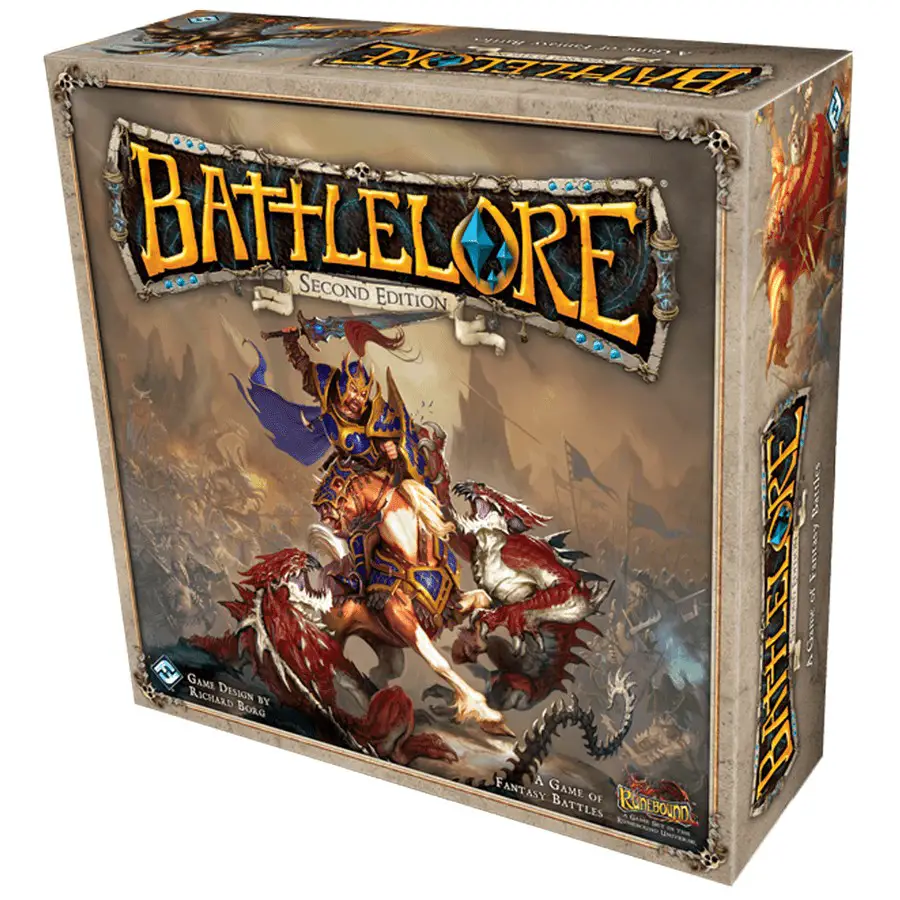
Players: 2
Duration: 45mins – 90mins
The final board game in my top 10 fantasy board game list is Battelore.
Battlelore is a 2-player fantasy themed wargame set in the world of Terrinoth.
The game has players command opposing armies that start on opposing sides of a dynamic modular tile map.
Battelore uses the same card driven mechanics in the immensely popular games like Memoir ’44 and Battlecry.
The game is really fun to play – especially if both players are competitive. Battelore relies on strategy and planning and allows players to create custom scenarios with a tailored landscape.
It’s also not as intense and hard to play as other wargames and the theme is very much a fantasy game – what’s not to love?
Gameplay
At the start of the game players choose which side they are going to play –
- The Blue Dagan Lords (humans); or
- The Red Uthuk Y’llan (demons).
Then players need to decide which scenario they will be playing (or if experienced they can make their own).
Scenario cards will provide details of how to construct each sides army as well as the layout of the board and the terrain – this is done in secret (i.e. the other player does not know in advance how the other player has set up their army).
Players then proceed on a turn by turn basis until the victory condition of the scenario is achieved.
Each turn a player must perform the following actions:
- Command: Players have 4 command cards in their hand. On a turn they much choose 1 of these cards and play it face up and resolve it (discarding after use).
- Order: Players are able to order their units around the map. Units are made up of miniatures with each additional miniature representing the unit’s health.
Which units you can order is all based on the command card played. Therefore, playing a command card is super important depending on your strategy.
- Movement: Players may decide which units they want to move based on their orders. Units are blocked by certain landscape tiles (eg. Water) or enemy troops).
- Attack: Players are able to attack enemy units using either melee or ranged attacks. Melee attacks can happen to enemy units in adjacent tiles. For ranged attacks players need line of site as well as an appropriate range to be able to attack from a distance.
Combat in game is resolved by rolling action dice. The amount of dice rolled depends on a units combat value.
Melee attacks hit on 2 sides of the dice, and ranged attacks hit on 1 side. The defending unit also might be made to retreat in a straight line away from the attacker. If the defending unit is not eliminated or forced to retreat, it may immediately counter attack (if adjacent to the attacking unit).
The game continues like this until either the entire opposing teams army is wiped off the map or one player amasses 16 victory points.
Victory points are earned by players taking over and holding strategic areas of the map (which is a great mechanic because it forces conflict!).
Bottom Line
Battelore is a great fantasy themed war game that strikes the perfect balance between simple gameplay that is both strategic and fun.
The game is super easy to learn for a war game and allows players (once they get the hang of it) to tailor make custom campaigns with the modular tile board.
Pros:
- Easy to learn for a war game
- Fantasy theme throughout
- Gameplay is quick and intense
Cons:
- Has a reasonably long set up time
- Luck based combat
Final Thoughts
So, there you have it, a list of what I believe are the best fantasy board games. I had to think long and hard about which games to include above as the fantasy genre is MASSIVE.
I have tried to include games that will interest a whole range of gamers and focus on a multitude of themes and mechanics of play.
I’m sure if like me, you are a fan of fantasy, there is a board game you will like in the list. I would love to hear your thoughts in the comments below.

